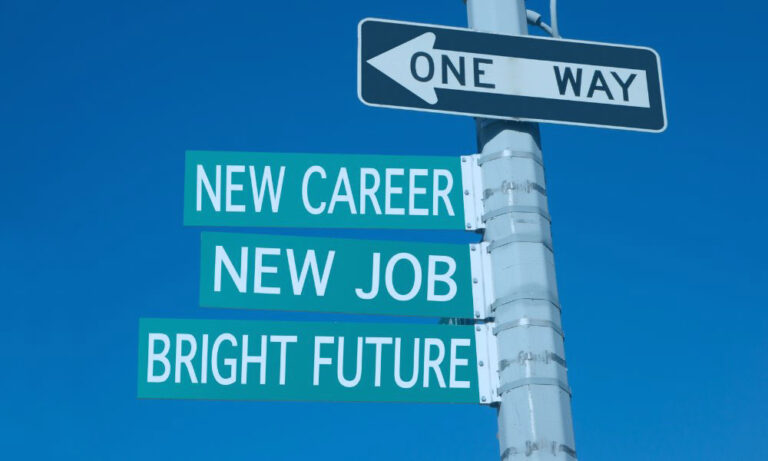Rethink, Rebrand, Reapply: The Ultimate Career Change Resume Guide
Crafting a nice and good resume is hard enough, crafting a career change[1] resume is just a pain in the butt.
Whereas in a normal resume, you just try your best to sell yourself, in a career change resume, you also have to prove the fact that you won’t run away anymore.
It’s like being an ex con in the eyes of the recruiters.
But, if you know what you are doing and know the challenges you are facing, you can very easily hit it out of the park, whether it’s a career change resume or career change cover letter[2].
Why a Career Change Resume is Different
Career change or job hopping can be a red flag to the recruiter and if you try to hide it or downplay it, the flag might get crimson.
So, as I’ve helped thousands of people during a career or industry shift, I know for a fact that the solution is – doubling down.
An employee with relevant education and industry experience is good, but you know what’s better?
An employee who’s willing to take the bull by the horn and always eager to learn and acquire new skills for the job.
It’s also crucial to spotlight the transferable skills and experiences you bring to the table for the new gig.
These wil showcase that you’re a top-notch contender for the job and that you’re eager to learn and thrive in your new role.
Here are some tricks of the trade on crafting a career change resume that will put your skills and successes front and center:
- Put the spotlight on your transferable skills and accomplishments that directly relate to the new role.
For instance, if you’re gunning for a leadership consultant position, make sure to tout your expertise and experience in that area on your resume.
- Showcase your past wins, as it speaks volumes about your value proposition as a potential employee.
- Don’t let any gaps in your work history trip you up, instead, turn them into a positive by showcasing your continuing education or volunteer experience.
This shows your dedication to constantly growing and bettering yourself in your career journey.
- Customize your resume for the specific role you’re applying for, highlighting your relevant experiences and skills that set you apart as a top candidate.
By doing this, you’ll make sure your resume lands in the right hands at the company and sets you on the path to success in your new career.
Key Elements of a Career Change Resume
When you’re making a career switch, your resume needs to be a standout to show off your skills and background in a new light.
Here are the must-have elements for your career change resume:
- Elevator Pitch: Start your resume with a personal summary that gives a quick rundown of who you are, what you’re aiming for, and why you’re making the leap. Keep it short, sweet, and tailored to the specific job you’re gunning for.
- Skills Showcase: This section is your chance to highlight your transferable skills and relevant tech abilities. Think problem-solving, leadership, communication, project management, and the like.
- Highlight Reel: Your work experience section is a chance to show off what you’ve accomplished and what value you brought to your past roles. Focus on your achievements, not just a list of job duties. And, of course, make sure it’s relevant to the new role you’re after.
- Education Background: This section should list your academic credentials, including any degrees, certifications, or training programs that show your qualifications for the new role.
- The Complete Package: Consider including additional sections, like certifications, volunteer experience, or language proficiency, to give the full picture of your skills and experience.
By incorporating these key elements, you’ll create a resume that showcases your transferable skills and relevant achievements, making you a top contender for the job you want.
Let’s talk about them in a bit more detail so you hit the bull’s eye sooner rather than later.
Personal Summary Statement or The Elevator Pitch
The Personal Summary Statement is the first chance you get to make a killer impression on the hiring manager.
Think of it as your elevator pitch, giving you the opportunity to showcase what sets you apart and why you’re the perfect fit for the job.
Here’s how to make your personal summary statement sing:
- Keep it short and sweet: Don’t make the hiring manager work too hard, just give them the highlights in a couple of sentences.
- Make it personal: Tailor your statement to the specific job you’re applying for, mentioning why you’re interested and how your skills and experience match up.
- Show your value: Let the hiring manager know what you bring to the table, highlighting your unique selling points, transferable skills, and accomplishments.
- Use the right lingo: Sprinkle in some relevant keywords from the job description to prove that you’ve done your homework.
By following these tips, you’ll craft a personal summary statement that makes you stand out and shows the hiring manager that you’re the whole enchilada.
Skills Section or The Main Showcase
Let’s talk about the Skills Section of your career change resume, which is like the icing on the cake.
This section highlights your transferable skills, or the know-how and abilities you’ve picked up in previous jobs that can be put to use in a new field.
These skills show that you’re a strong candidate who can hit the ground running in your new career.
Here are some examples of transferable skills that you can include in your skills section:
- Leadership: If you’ve had experience leading the charge on teams or projects, that’s a real asset.
- Communication: Being able to get your point across both in writing and in person is a hot commodity in any industry.
- Problem-solving: If you’ve got a knack for finding solutions to complex problems, that’s a real feather in your cap.
- Adaptability: Being able to roll with the punches and adjust to new environments quickly can be a big plus for someone making a career change.
- Time management: Showing that you can manage your time and get the job done efficiently can be a valuable skill in any role.
It’s a good idea to mix in both hard and soft skills to show that you’re a well-rounded candidate.
The goal is to show the hiring manager that you have the skills it takes to succeed in the new role, even if it’s a big change from what you’ve done before.
Work Experience Section
The Work Experience section of your career change resume is where you get to show what you bring to the table.
It’s your chance to showcase your previous work history and the skills and experiences that make you a strong candidate for your new job.
Here’s how to make the most of it:
- Focus on What Matters: When listing your work history, pick positions and accomplishments that are relevant to your new role.
This shows the hiring manager that you’re a good fit for the job.
- Showcase Your Wins: Instead of just listing your job duties, take the time to highlight your accomplishments in each role.
This could be anything from meeting targets, exceeding sales goals, leading projects, or managing teams.
- Use the Right Keywords: Look for keywords in the job posting and make sure to include them in your work experience section.
This makes it easier for the hiring manager to see that you’re a strong fit for the role and increases the chances of your resume getting a second look.
- Get Specific: Use quantifiable data and statistics to back up your achievements. For example, instead of saying “improved sales,” you could say “boosted sales by 20% in 6 months.”
The Work Experience section is not only a chance to showcase your achievements, but also your responsibilities and the skills you developed in each role.
This paints a complete picture of your background and the value you bring to the table, making you stand out as a strong candidate for your new career.
Education Background Section
The education section of your resume is your chance to show off your smarts and all that extra training you’ve received.
To make sure you’re playing your cards right, include the following:
- Your highest level of education and the name of the school where you got it
- The date you graduated.
- Any classes or coursework that are relevant to your new career path.
- Any projects or papers that show off your skills and knowledge in the field.
Even if you don’t have a formal degree in your new career, any relevant classes or projects you’ve tackled can still give you a leg up.
By showcasing your education and training, you’re sending a message loud and clear that you’re ready to tackle this new path head-on.
Tips for Crafting a Winning Career Change Resume
If you’re looking to make a big change in your career, you want your resume to be top-notch and stand out from the crowd.
Here are some tips to help you hit a home run with your career change resume:
- Tailor your resume specifically for the job you’re applying for. Make sure to emphasize your relevant skills and experiences that make you the best fit for the role.
- Highlight specific achievements from past roles and quantify them as much as possible to really show off your value proposition.
- Use keywords relevant to the job you’re applying for to optimize your resume for ATS[3] (Applicant Tracking Systems) and ensure it gets seen by the right people.
- Make your resume easy to read and visually appealing. Use bullet points and headings to break up the text and make it easier to scan.
- Consider adding a personal summary statement at the top of your resume to give a quick and concise overview of your background and skills.
By following these tips, you’ll be putting your best foot forward and setting yourself up for success in your career change.
Tailor Your Resume for Each Job
When you think about it from the recruiters’ perspective, it just makes sense to tailor your resume to fit the specific job you’re applying for.
Sure, you can have a generic resume and it might as well work but try to put yourself in the recruiters shoes.
Ten applicants with similar resumes go to the bar. Who gets the job?
The person with the most experience and laser focused education for the industry right?
So, don’t try to compete where you’re already weak. There is no such thing as a level playing field in the real world.
But you can ofcourse, try to make your own field where you’re the boss. That’s why it’s better to show the employer you’re a custom fit for the role by making a few tweaks.
Here’s how:
- Read the job description carefully – pay attention to the key skills and requirements mentioned.
- Highlight relevant experiences and achievements from your work history that match what the employer is looking for.
- Use language that aligns with the company culture and mirrors the language used in the job posting.
- Show, don’t tell – use concrete examples of how you’ve demonstrated the skills and achievements the employer is seeking.
By taking the time to tailor your resume for each job, you’ll show the employer that you’re a good fit and a strong candidate for the role.
And who knows, you just might hit the bullseye with your next career move!
Sprinkle Keywords Like Magic
Including keywords in your career change resume is a big deal, because it makes sure your resume is a good match for job postings and helps you stand out to recruiters and hiring managers.
Think of keywords as secret code words that they use to search their databases for candidates just like you.
By slipping these magic words into your resume, you increase the odds that you’ll be found and considered for the job.
To find the right keywords – check out job postings for positions you’re interested in and make a list of the common terms and phrases that pop up.
You can also do some online research by looking at job search websites and industry-specific sites to see what words are hot.
Once you have your list of keywords, sprinkle them into your resume like salt and pepper.
Start with your summary, skills section, and work experience section, but don’t overdo it.Too many keywords can make your resume seem fake and robotic.
The goal is to strike a balance between keywords and well-written, descriptive language that shows who you are and what you bring to the table.
Make sure the keywords you use are a true reflection of your skills and experiences, so you’re considered for jobs that are a good fit for you.
Examples of Keywords for a Career Change Resume
Here are some buzzwords that are often included in career change resumes:
- Transferable know-how: being able to work with others, making decisions, fixing problems, running the show, being a team player, helping customers.
- Jargon of your future industry: talking the talk, making software, planning marketing campaigns, crunching numbers, working with data, running a healthcare office.
- Letters after your name: Master of Business Administration, Project Management Professional, Certified Public Accountant, Registered Nurse, Information Technology Infrastructure Library, Six Sigma[4].
- Bragging rights: bringing in more money, making things run smoother, making customers happy, bringing in new technology, leading a team, finishing projects with flying colors.
- Computer smarts: knowing Microsoft Office, being familiar with Adobe Creative Suite, being able to code in HTML, CSS, and SQL, having experience with Python, knowing SAP[5].
- People skills: being able to roll with the punches, thinking outside the box, managing your time, paying attention to detail, getting along with others, being creative.
Remember, these are just a few examples, and the keywords you put in your resume will depend on your unique skills, background, and career aspirations.
Do your homework, and make sure you’re using keywords that will make you stand out in your desired field.
Use Action Verbs Rather than Passive Language
Action verbs in a resume refer to powerful verbs that help describe the candidate’s accomplishments and responsibilities in past roles.
Using action verbs in your resume is like putting your best foot forward. It gives your experiences and achievements a boost and helps you stand out from the crowd.
By using action verbs, you’re painting a picture for recruiters that’s clear and memorable. Instead of saying “Responsible for managing a team” you can say “Steered a team to success” This not only sounds more impressive, but it also shows recruiters exactly what you accomplished in that role.
Action verbs are like the secret sauce in your resume. They help to optimize it for those applicant tracking systems (ATS) and increase your chances of being noticed by recruiters.
And when you use action verbs, you’re showing recruiters that you’re a go-getter who knows how to get things done.
In short, using action verbs in your resume is a no-brainer. It’ll help you put your best self forward and increase your chances of landing that dream job.
Examples of Action Verbs for a Career Change Resume
Here’s a list of action verbs I found from Harvard school resources. Keep it as your secret source and use it wisely.
Action Verbs vs Keywords in Resume: What’s the Difference?
Having the right combination of keywords and action verbs in your resume is like hitting the jackpot.
It helps you make a strong first impression and show recruiters that you have the skills and experience they’re looking for.
Keywords are the buzzwords and phrases related to the job, such as “social media marketing” or “data analysis.” Including these in your resume shows recruiters that you’re on their wavelength and know the lingo.
Action verbs, on the other hand, are the heavy hitters that help you sell yourself. Words like “spearheaded,” “turned around,” and “delivered” showcase your past achievements and show recruiters that you’re a self-starter who knows how to get things done.
The trick to making the most of both keywords and action verbs is to find the right balance.
Don’t overdo it and make your resume look like a jumbled mess. Instead, use the right keywords and action verbs strategically to present your qualifications and experiences in a way that’s easy for recruiters to understand.
Think of keywords and action verbs as the spice in your resume recipe. Use them smartly and recruiters will be eager to bring you in for an interview.
Get a Second Opinion
Having a fresh pair of eyes take a look at your career change resume can be a real game-changer.
Here are a few benefits of getting a second opinion:
- Honest feedback: Having someone else give their take on your resume can provide a new angle and highlight areas for improvement.
- No more slip-ups: Having someone else review your resume can help catch any typos, grammatical errors, or mistakes you may have missed.
- New insights: An outside perspective can offer new ideas and show you how potential employers might view your resume.
So who should you turn to for feedback on your career change resume? Here are a few suggestions:
- Your mentor: If you have a mentor in the field you’re looking to switch to, they can give you the inside scoop on what employers in that industry are looking for.
- Career coach: A career coach can give you a professional assessment of your resume and help you tailor it to meet your career goals.
- Recruiter: Recruiters see plenty of resumes, and they can give you specific feedback on what they look for in a career change resume.
- Colleagues or friends in your desired field: Asking someone who’s already in the field you’re looking to break into for feedback on your resume can give you a good idea of what the standards are and what employers are looking for.
The bottom line is, don’t be shy about getting a second opinion on your resume. If you’re not confident enough to show it to the people you know, maybe it’s not good enough.
Try to craft a resume that you’re proud to show everyone. Things you’re proud of are actually quite easy to sell.
The goal is to make it the best it can be, and getting feedback from others can only help. Be open to constructive criticism, and you’ll be one step closer to landing your dream job.
Tech and Services for Your Career Change Resume: Proceed with Caution
It’s a common thing nowadays, and it seems to be getting more popular by the day.
I’ve heard people are relying on AI to write their resumes, or paying for cheap resume services for as little as 30 bucks a pop.
Now, there’s nothing inherently wrong with using these services, but if you don’t understand how to use them correctly and treat them as a one-stop solution, you’re starting off on the wrong foot in your career change journey.
- When it comes to AI and your career change resume, think of it as more of a helper than a writer. AI can make the resume submission process faster and easier, but it shouldn’t actually write your resume for you.
- And when it comes to services, use them as a template for your resume, not as the actual resume you’ll be submitting.
The bottom line is, there’s no quick fix, no matter how much you would like it to be so.
The only thing that really works is putting in the time and effort to make your resume stand out. So, buckle down and grind it out.
I will talk about how you can effectively use AI and other services in your career journey later in another article.
I haven’t started putting out a subscription option to get in our mailing list yet so stay tuned and check the site regularly for updates for now.
Bottom Line
Recruiters claim they spend anywhere between 15 seconds to 15 minutes to review a candidate’s resume.
But from my experience and according to current research data, it doesn’t look like they spend more than 6-8 seconds for each.
Now the time may vary wildly depending on the type of job or the expertise level but as a career shifter, it’s very likely that you’re not applying for the top positions.
So 6-8 seconds will most likely be the case for you.
You may ask, even after all this, how will you stand out if they’re only spending 6 seconds on your resume.
The solution to this is, making your resume scannable.
Remember we talked about the summary and keywords in your resume? That is part of it.
But don’t think about it for now, first make a template for your resume the way I’ve written in this article and keep applying.
You’ll already be ahead of at least 80% this way.
In some future article, I will show you how you can make your resume more scannable and primed for success.








2 Comments